Nutrient Removal Potential of Headwater Wetlands in Coastal Plains of Alabama, USA
Abstract
:1. Introduction
2. Study Area
3. Methods
3.1. Modeling Framework
3.2. Model Uncertainty
3.3. Assessment of Nutrient Removal Rates by Wetlands
4. Results
4.1. Nutrient Removals and Their Efficiencies
4.2. Nutrient Removal Efficiencies and Wetland Characteristics
4.3. Impact of Dry/Wet Years
5. Discussion
6. Summary and Conclusions
Supplementary Materials
Author Contributions
Funding
Data Availability Statement
Conflicts of Interest
References
- Hathaway, J.M.; Hunt, W.F. Evaluation of storm-water wetlands in series in Piedmont North Carolina. J. Environ. Eng. 2010, 136, 140–146. [Google Scholar] [CrossRef]
- Cohen, M.; Creed, I.F.; Alexander, L.; Basu, N.B.; Calhoun, A.J.K.; Craft, C.; D’Amico, E.; DeKeyser, E.; Fowler, L.; Golden, H.E. Do geographically isolated wetlands influence landscape functions. Proc. Natl. Acad. Sci. USA 2016, 113, 1978–1986. [Google Scholar] [CrossRef]
- Wang, X.X.; Shang, S.Y.; Qu, Z.Y.; Liu, T.X.; Melesse, A.M.; Yang, W.H. Simulated wetland conservation-restoration effects on water quantity and quality at watershed scale. J. Environ. Manag. 2010, 91, 1511–1525. [Google Scholar] [CrossRef] [PubMed]
- Dwivedi, D.; Godsey, S.E.; Scheibe, T.D. Editorial: Linking Hydrological and Biogeochemical Processes in Riparian Corridors. Front. Water 2021, 3, 49. [Google Scholar] [CrossRef]
- Bouwman, A.F.; Bierkens, M.F.P.; Griffioen, J.; Hefting, M.M.; Middelburg, J.J.; Middelkoop, H.; Slomp, C.P. Nutrient dynamics, transfer and retention along the aquatic continuum from land to ocean: Towards integration of ecological and biogeochemical models. Biogeosciences 2013, 10, 1–22. [Google Scholar] [CrossRef] [Green Version]
- Piña-Ochoa, E.; Álvarez-Cobelas, M. Denitrification in Aquatic Environments: A Cross-system Analysis. Biogeochemistry 2006, 81, 111–130. [Google Scholar] [CrossRef]
- Saunders, D.L.; Kalff, J. Nitrogen retention in wetlands, lakes and rivers. Hydrobiologia 2001, 443, 205–212. [Google Scholar] [CrossRef]
- Seitzinger, S.; Harrison, J.A.; Böhlke, J.K.; Bouwman, A.F.; Lowrance, R.; Peterson, B.; Tobias, C.; Drecht, G.V. Denitrification Across Landscapes and Waterscapes: A Synthesis. Ecol. Appl. 2006, 16, 2064–2090. [Google Scholar] [CrossRef] [Green Version]
- Cheng, F.Y.; Basu, N.B. Biogeochemical hotspots: Role of small water bodies in landscape nutrient processing. Water Resour. Res. 2017, 53, 5038–5056. [Google Scholar] [CrossRef] [Green Version]
- Golden, H.E.; Rajib, A.; Lane, C.R.; Christensen, J.R.; Wu, Q.; Mengistu, S. Non-floodplain Wetlands Affect Watershed Nutrient Dynamics: A Critical Review. Environ. Sci. Technol. 2019, 53, 7203–7214. [Google Scholar] [CrossRef]
- Jordan, S.J.; Stoffer, J.; Nestlerode, J. Wetlands as sinks for reactive nitrogen at continental and global scales: A meta-analysis. Ecosystems 2011, 14, 144–155. [Google Scholar] [CrossRef]
- Fisher, J.; Acreman, M.C. Wetland nutrient removal: A review of the evidence. Hydrol. Earth Syst. Sci. 2004, 8, 673–685. [Google Scholar] [CrossRef] [Green Version]
- Land, M.; Granéli, W.; Grimvall, A.; Hoffmann, C.C.; Mitsch, W.J.; Tonderski, K.S.; Verhoeven, J.T.A. How effective are created or restored freshwater wetlands for nitrogen and phosphorus removal? A systematic review. Environ. Evid. 2016, 5, 9. [Google Scholar] [CrossRef] [Green Version]
- Hansen, A.T.; Dolph, C.L.; Foufoula-Georgiou, E.; Finlay, J.C. Contribution of wetlands to nitrate removal at the watershed scale. Nat. Geosci. 2018, 11, 127–132. [Google Scholar] [CrossRef]
- Isik, S.; Singh, V.P. Hydrologic regionalization of watersheds in Turkey. J. Hydrol. Eng. 2008, 13, 824–834. [Google Scholar] [CrossRef]
- Fink, D.F.; Mitsch, W.J. Seasonal and storm event nutrient removal by a created wetland in an agricultural watershed. Ecol. Eng. 2004, 23, 313–325. [Google Scholar] [CrossRef]
- Han, L.; Randhir, T.O.; Huang, M. Design and assessment of stream–wetland systems for nutrient removal in an urban watershed of China. Water Air Soil Pollut. 2017, 228, 139. [Google Scholar] [CrossRef]
- Ramesh, R.; Anderson, C.; Kalin, L. Characterizing Nitrogen Attenuation by Headwater Slope Wetlands across Different Land Uses. Ecol. Eng. 2020, 149, 105833. [Google Scholar] [CrossRef]
- Yang, W.; Wang, X.; Liu, Y.; Gabor, S.; Boychuk, L.; Badiou, P. Simulated environmental effects of wetland restoration scenarios in a typical Canadian prairie watershed. Wetl. Ecol Manag. 2010, 18, 269–279. [Google Scholar] [CrossRef]
- Liu, Y.; Yang, W.; Shao, H.; Yu, Z.; Lindsay, J. Development of an Integrated Modelling System for Evaluating Water Quantity and Quality Effects of Individual Wetlands in an Agricultural Watershed. Water 2018, 10, 774. [Google Scholar] [CrossRef] [Green Version]
- Uuemaa, E.; Palliser, C.C.; Hughes, A.O.; Tanner, C.C. Effectiveness of a Natural Headwater Wetland for Reducing Agricultural Nitrogen Loads. Water 2018, 10, 287. [Google Scholar] [CrossRef] [Green Version]
- Czuba, J.A.; Hansen, A.T.; Foufoula-Georgiou, E.; Finlay, J.C. Contextualizing wetlands within a river network to assess nitrate removal and inform watershed management. Water Resour. Res. 2018, 54, 1312–1337. [Google Scholar] [CrossRef]
- Hansen, A.T.; Campbell, T.; Cho, S.J.; Czuba, J.A.; Dalzell, B.J.; Dolph, C.L.; Hawthorne, P.L.; Rabotyagov, S.; Lang, Z.; Kumarasamy, K.; et al. Integrated assessment modeling reveals near-channel management as cost-effective to improve water quality in agricultural watersheds. Proc. Natl. Acad. Sci. USA 2021, 118, e2024912118. [Google Scholar] [CrossRef] [PubMed]
- Ghermandi, A.; van den Bergh, J.C.J.M.; Brander, L.M.; de Groot, H.L.F.; Nunes, P.A.L.D. Values of natural and human-made wetlands: A meta-analysis. Water Resour. Res. 2010, 46. [Google Scholar] [CrossRef] [Green Version]
- Akamatsu, Y.; Ikeda, S. Surface and subsurface water coupled ecological model in a mangrove swamp, Ishigaki Island, Japan. J. Hydro-Environ. Res. 2016, 11, 146–159. [Google Scholar] [CrossRef]
- Sharifi, A.; Hantush, M.; Kalin, L. Modeling Nitrogen, Carbon and Phosphorus dynamics in wetland soils and water using a mechanistic wetland model. J. Hydrol. Eng. 2017, 22, 1–8. [Google Scholar] [CrossRef]
- Arnold, J.G.; Srinivasan, R.; Muttiah, R.S.; Williams, J.R. Large-area hydrologic modeling and assessment: Part I. Model development. J. American Water Resources Assoc. 1998, 34, 73–89. [Google Scholar] [CrossRef]
- Hantush, M.M.; Kalin, L.; Isik, S.; Yucekaya, A. Nutrient Dynamics in Flooded Wetlands. I: Model Development. J. Hydrol. Eng. 2013, 18, 1709–1723. [Google Scholar] [CrossRef] [Green Version]
- Kalin, L.; Hantush, M.; Isik, S.; Yucekaya, A.; Jordan, T. Nutrient Dynamics in Flooded Wetlands. II: Model Application. J. Hydrol. Eng. 2013, 18, 1724–1738. [Google Scholar] [CrossRef] [Green Version]
- Sharifi, A.; Kalin, L.; Hantush, M.M.; Isik, S.; Jordan, T.E. Carbon dynamics and export from flooded wetlands: A modeling approach. Ecol. Modell. 2013, 263, 196–210. [Google Scholar] [CrossRef] [Green Version]
- Minzoni, R.T.; Parker, L.E.; Wallace, D.J.; Lambert, W.J.; Elliott, E.A.; Andrus, C.F.T.; Lehrmann, A.A. A 7000-year record of floods and ecological feedbacks in Weeks Bay, Alabama, USA. Sci. Total Environ. 2020, 743, 140052. [Google Scholar] [CrossRef]
- Mortazavi, B.; Riggs, A.A.; Caffrey, J.M.; Genet, H.; Phipps, S.W. The Contribution of Benthic Nutrient Regeneration to Primary Production in a Shallow Eutrophic Estuary, Weeks Bay, Alabama. Estuaries Coasts 2012, 35, 862–877. [Google Scholar] [CrossRef]
- Neumann, B.; Vafeidis, A.T.; Zimmermann, J.; Nicholls, R.J. Future Coastal Population Growth and Exposure to Sea-Level Rise and Coastal Flooding-A Global Assessment. PLoS ONE 2015, 10, e0118571. [Google Scholar] [CrossRef] [PubMed] [Green Version]
- Small, C.; Nicholls, R.J. A Global Analysis of Human Settlement in Coastal Zones. J. Coast. Res. 2003, 19, 584–599. [Google Scholar]
- Walsh, C.J.; Roy, A.H.; Feminella, J.W.; Cottingham, P.D.; Groffman, P.M.; Morgan, R.P. The urban stream syndrome: Current knowledge and the search for a cure. J. North Am. Benthol. Soc. 2005, 24, 706–723. [Google Scholar] [CrossRef]
- Freeman, M.C.; Pringle, C.M.; Jackson, C.R. Hydrologic connectivity and the contribution of stream headwaters to ecological integrity at regional scales. JAWRA J. Am. Water Resour. Assoc. 2007, 43, 5–14. [Google Scholar] [CrossRef]
- Colvin, S.A.R.; Sullivan, S.M.P.; Shirey, P.D.; Colvin, R.W.; Winemiller, K.O.; Hughes, R.M.; Fausch, K.D.; Infante, D.M.; Olden, J.D.; Bestgen, K.R.; et al. Headwater Streams and Wetlands are Critical for Sustaining Fish, Fisheries, and Ecosystem Services. Fisheries 2019, 44, 73–91. [Google Scholar] [CrossRef]
- Brinson, M.M. Changes in the functioning of wetlands along environmental gradients. Wetlands 1993, 13, 65–74. [Google Scholar] [CrossRef]
- Rheinhardt, R.D.; Rheinhardt, M.C.; Brinson, M.M.; Faser, K. Forested wetlands of low order streams in the inner coastal plain of North Carolina, USA. Wetlands 1998, 18, 365–378. [Google Scholar] [CrossRef]
- US Geological Survey, 2016. National Water Information System data available on the World Wide Web (USGS Water Data for the Nation). Available online: http://waterdata.usgs.gov/nwis/ (accessed on 10 May 2020).
- WBWMP, Weeks Bay Watershed Management Plan, 2017. Baldwin County, Alabama. Available online: https://www.mobilebaynep.com/assets/pdf/Weeks_Bay_WMP_Main_Report_Final.pdf (accessed on 1 November 2022).
- National Water Quality Monitoring Council, 2022. Available online: http://www.waterqualitydata.us (accessed on 15 April 2022).
- Dewitz, J.; National Land Cover Database (NLCD) 2016 Products: U.S. Geological Survey Data Release 2019. Available online: https://www.sciencebase.gov/catalog/item/5d4c6a1de4b01d82ce8dfd2f (accessed on 22 February 2021).
- Araza, A.; Perez, M.; Cruz, R.V.; Aggabao, L.F.; Soyosa, E. Probable streamflow changes and its associated risk to the water resources of Abuan watershed, Philippines caused by climate change and land use changes. Stoch. Env. Res. Risk Assess 2021, 35, 389–404. [Google Scholar] [CrossRef]
- Dosdogru, F.; Kalin, L.; Wang, R.; Yen, H. Potential impacts of land use/cover and climate changes on ecologically relevant flows. J. Hydrol. 2020, 584, 124654. [Google Scholar] [CrossRef]
- Galleguillos, M.; Gimeno, F.; Puelma, C.; Zambrano-Bigiarini, M.; Lara, A.; Rojas, M. Disentangling the effect of future land use strategies and climate change on streamflow in a Mediterranean catchment dominated by tree plantations. J. Hydrol. 2021, 595, 126047. [Google Scholar] [CrossRef]
- Salmoral, G.; Willaarts, B.A.; Troch, P.A.; Garrido, A. Drivers influencing streamflow changes in the Upper Turia basin, Spain. Sci. Total Environ. 2015, 503–504, 258–268. [Google Scholar] [CrossRef] [PubMed]
- Abbaspour, K.C.; Yang, J.; Maximov, I.; Siber, R.; Bogner, K.; Mieleitner, J.; Srinivasan, R. Modelling hydrology and water quality in the pre-alpine/alpine Thur watershed using SWAT. J. Hydrol. 2007, 333, 413–430. [Google Scholar] [CrossRef]
- Noori, N.; Kalin, L.; Isik, S. Water quality prediction using SWAT-ANN coupled approach. J. Hydrol. 2020, 590, 125220. [Google Scholar] [CrossRef]
- Ullrich, A.; Volk, M. Application of the Soil and Water Assessment Tool (SWAT) to predict the impact of alternative management practices on water quality and quantity. Agric. Water Manag. 2009, 96, 1207–1217. [Google Scholar] [CrossRef]
- Wang, R.; Kalin, L. Combined and synergistic effects of climate change and urbanization on water quality in the Wolf Bay watershed, southern Alabama. J. Environ. Sci. 2018, 64, 107–121. [Google Scholar] [CrossRef]
- Neitsch, S.L.; Arnold, J.G.; Kiniry, J.R.; Williams, J.R. Soil and Water Assessment Tool, Theoretical Documentation, Version 2009; Texas Water Resources Institute Technical Report No. 406; Texas A&M University: College Station, TX, USA, 2011; Available online: https://swat.tamu.edu (accessed on 15 April 2021).
- ESRI. ArcGIS Desktop (10.4); Environmental Systems Research Institute: Redlands, CA, USA, 2015. [Google Scholar]
- Reckhow, K.; Qian, S. Modeling phosphorus trapping in wetlands using generalized additive-models. Water Resour. Res. 1994, 30, 3105–3114. [Google Scholar] [CrossRef]
- Camacho, R.A.; Martin, J.L.; Diaz-Ramirez, J.; McAnally, W.; Rodriguez, H.; Suscy, P.; Zhang, S. Uncertainty analysis of estuarine hydrodynamic models: An evaluation of input data uncertainty in the weeks bay estuary, alabama. Appl. Ocean. Res. 2014, 47, 138–153. [Google Scholar] [CrossRef]
- Abbaspour, K.C. SWAT-Calibration and Uncertainty Programs (CUP)—A User Manual; Swiss Federal Institute of Aquatic Science and Technology: Duebendorf, Switzerland, 2015; pp. 1–100. [Google Scholar]
- Baker, D.B.; Richards, R.T.; Loftus, T.; Kramer, J.W. A new flashiness index: Characteristics and applications to Midwestern rivers and streams. J. Am. Water Resour. Assoc. 2004, 40, 503–522. [Google Scholar] [CrossRef]
- Lim, K.J.; Engel, B.A.; Tang z Choi, J.; Kim, K.S.; Muthukrishnan, S.; Tripathy, D. Automated Web GISBased Hydrograph Analysis Tool, WHAT. J. Am. Water Resour. Assoc. 2005, 41, 1407–1416. [Google Scholar] [CrossRef]
- Junk, W.J.; Bayley, P.B.; Sparks, R.E. The flood pulse concept in river-floodplain systems. Can. Spec. Publ. Fish. Aquat. Sci. 1989, 106, 110–127. [Google Scholar]
- Odum, W.E.; Odum, E.P.; Odum, H.T. Nature’s pulsing paradigm. Estuaries 1995, 18, 547–555. [Google Scholar] [CrossRef]
- Suttles, K.M.; Singh, N.K.; Vose, J.M.; Martin, K.L.; Emanuel, R.E.; Coulston, J.W.; Saia, S.M.; Crump, M.T. Assessment of hydrologic vulnerability to urbanization and climate change in a rapidly changing watershed in the Southeast U.S. Sci. Total Environ. 2018, 645, 806–816. [Google Scholar] [CrossRef] [PubMed]
- Windolf, J.; Jeppesen, E.; Jensen, J.P.; Kristensen, P. Modelling of Seasonal Variation in Nitrogen Retention and in-Lake Concentration: A Four-Year Mass Balance Study in 16 Shallow Danish Lakes. Biogeochemistry 1996, 33, 25–44. [Google Scholar] [CrossRef]
- Spieles, D.J.; Mitsch, W.J. The effects of season and hydrologic and chemical loading on nitrate retention in constructed wetlands: A comparison of low-and high-nutrient riverine systems. Ecol. Eng. 1999, 14, 77–91. [Google Scholar] [CrossRef]
- Ulén, B.; Geranmayeh, P.; Blomberg, M.; Bieroza, M. Seasonal variation in nutrient retention in a free water surface constructed wetland monitored with flow-proportional sampling and optical sensors. Ecol. Eng. 2019, 139, 105588. [Google Scholar] [CrossRef]
- Jaramillo, F.; Brown, I.; Castellazzi, P.; Espinosa, L.; Guittard, A.; Hong, S.H.; Rivera-Monroy, V.H.; Wdowinski, S. Assessment of hydrologic connectivity in an ungauged wetland with InSAR observations. Environ. Res. Lett. 2018, 13, 024003. [Google Scholar] [CrossRef]
- Gassman, P.W.; Reyes, M.R.; Green, C.H.; Arnold, J.G. The soil and water assessment tool: Historical development, applications, and future research directions. Trans. ASABE 2007, 50, 1211–1250. [Google Scholar] [CrossRef] [Green Version]
- Butler, G.A.; Srivastava, P. An Alabama BMP database for evaluating water quality impacts of alternative management practices. Appl. Eng. Agric. 2007, 23, 727–736. [Google Scholar] [CrossRef]
- USDA National Agricultural Statistics Service. Census of Agriculture. 2017. Available online: https://www.nass.usda.gov/Publications/AgCensus/2017/index.php (accessed on 18 September 2019).
- Yang, Q.; Zhang, X. Improving SWAT for simulating water and carbon fluxes of forest ecosystems. Sci. Total Environ. 2016, 569–570, 1478–1488. [Google Scholar] [CrossRef]
- Yang, Q.; Zhang, X.; Almendinger, J.E.; Huang, M.; Leng, G.; Zhou, Y.; Qiu, J. Improving the SWAT forest module for enhancing water resource projections: A case study in the St. Croix River Basin. Hydrol. Process. 2018. [Google Scholar] [CrossRef]
- Haas, H.; Reaver, N.G.; Karki, R.; Kalin, L.; Srivastava, P.; Kaplan, D.A.; Gonzalez-Benecke, C. Improving the representation of forests in hydrological models. Sci. Total Environ. 2022, 812, 151425. [Google Scholar] [CrossRef]
- Runkel, R.L.; Crawford, C.G.; Cohn, T.A. Load estimator (LOADEST): A FORTRAN program for estimating constituent loads in streams and rivers. Tech. Methods 2004. [Google Scholar] [CrossRef] [Green Version]
- Sharifi, A.; Kalin, L.; Hantush, M.M.; O’Geen, A.T.; Dahlgren, R.A.; Maynard, J.J. Capturing spatial variability of concentrations and reaction rates in wetland water and soil through model compartmentalization. J. Hydrol. Eng. 2015. [Google Scholar] [CrossRef] [Green Version]
- Bischoff, J.M.; Bukaveckas, P.; Mitchell MJHurd, T.N. Storage and Cycling in Vegetation of a Forested Wetland: Implications for Watershed N Processing. Water Air Soil Pollution 2001, 128, 97–114. [Google Scholar] [CrossRef]
- Clawson, R.G.; Lockaby, B.G.; Rummer, B. Changes in production and nutrient cycling across a wetness gradient within a floodplain forest. Ecosystems 2001, 4, 126–138. [Google Scholar] [CrossRef]
- Moriasi, D.N.; Arnold, J.G.; Liew, M.W.V.; Bingner, R.L.; Harmel, R.D.; Veith, T.L. Model evaluation guidelines for systematic quantification of accuracy in watershed simulations. Trans. ASABE 2007, 50, 885–900. [Google Scholar] [CrossRef]
- Moriasi, D.N.; Gitau, M.W.; Pai, N.; Daggupati, P. Hydrologic and water quality models: Performance measures and evaluation criteria. Trans. ASABE 2015, 58, 1763–1785. [Google Scholar] [CrossRef] [Green Version]
- Rocha, E.O.; Calijuri, M.L.; Santiago, A.F.; De Assis, L.C.; Alves, L.G. The Contribution of Conservation Practices in Reducing Runoff, Soil Loss, and Transport of Nutrients at the Watershed Level. Water Resour. Manag. 2012, 26, 3831–3852. [Google Scholar] [CrossRef]
- Strauch, M.; Volk, M. SWAT plant growth modification for improved modeling of perennial vegetation in the tropics. Ecol. Model. 2013, 269, 98–112. [Google Scholar] [CrossRef]
- Memarian, H.; Balasundram, S.K.; Abbaspour, K.C.; Talib, J.B.; Boon Sung, C.T.; Sood, A.M. SWAT-based hydrological modelling of tropical land-use scenarios. Hydrol. Sci. J. 2014, 59, 1808–1829. [Google Scholar] [CrossRef]
- Taylor, S.D.; He, Y.; Hiscock, K.M. Modelling the impacts of agricultural management practices on river water quality in Eastern England. J. Environ. Manag. 2016, 180, 147–163. [Google Scholar] [CrossRef] [Green Version]
- Wu, Y.; Chen, J. Analyzing the Water Budget and Hydrological Characteristics and Responses to Land Use in a Monsoonal Climate River Basin in South China. Environ. Manag. 2013, 51, 1174–1186. [Google Scholar] [CrossRef] [PubMed]
- Kalin, L.; Hantush, M.; Isik, S. WetQual GUI User Manual Rel. 2; EPA/600/R-20/257; U.S. EPA Office of Research and Development: Washington, DC, USA, 2020. [Google Scholar]
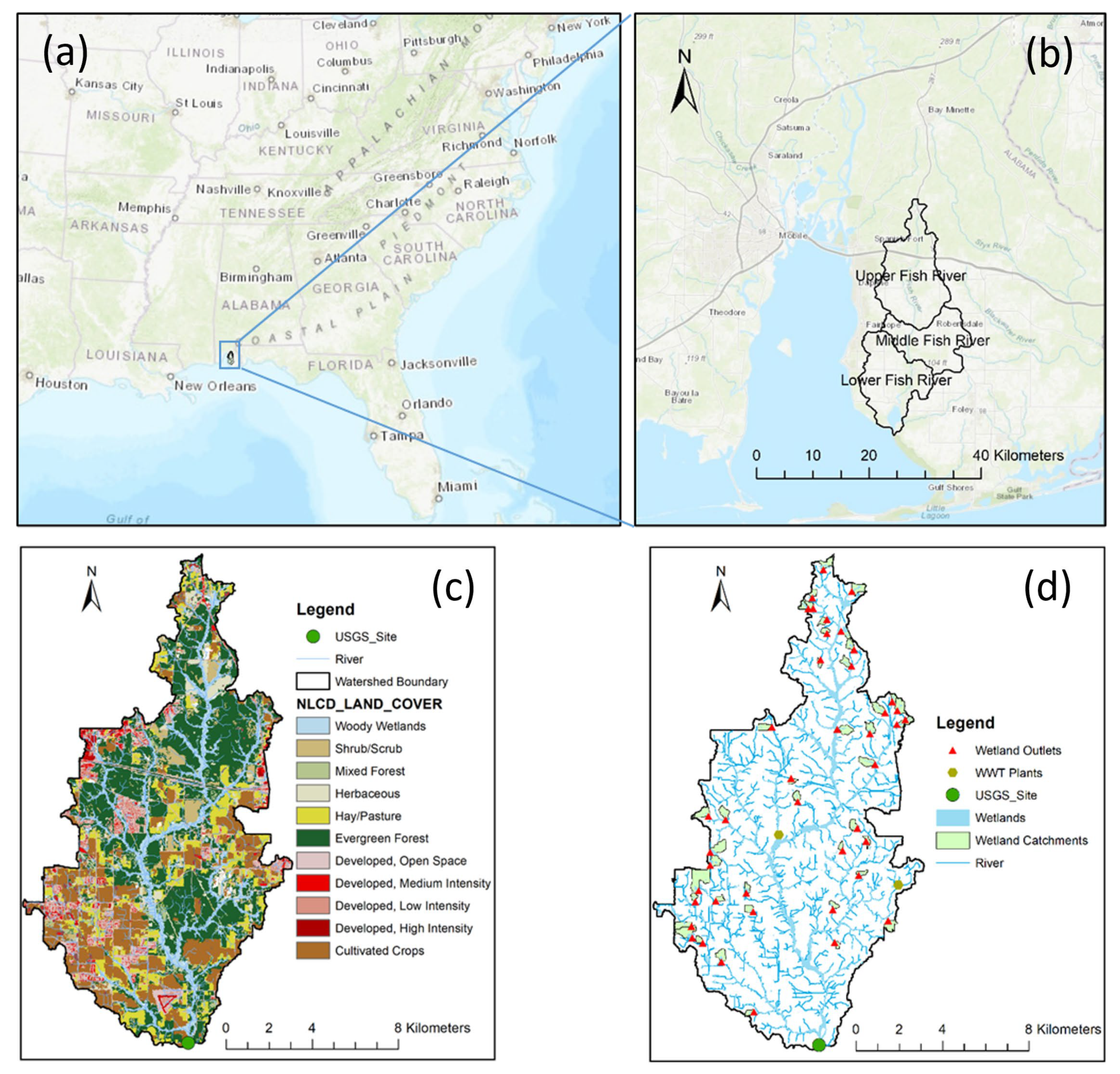

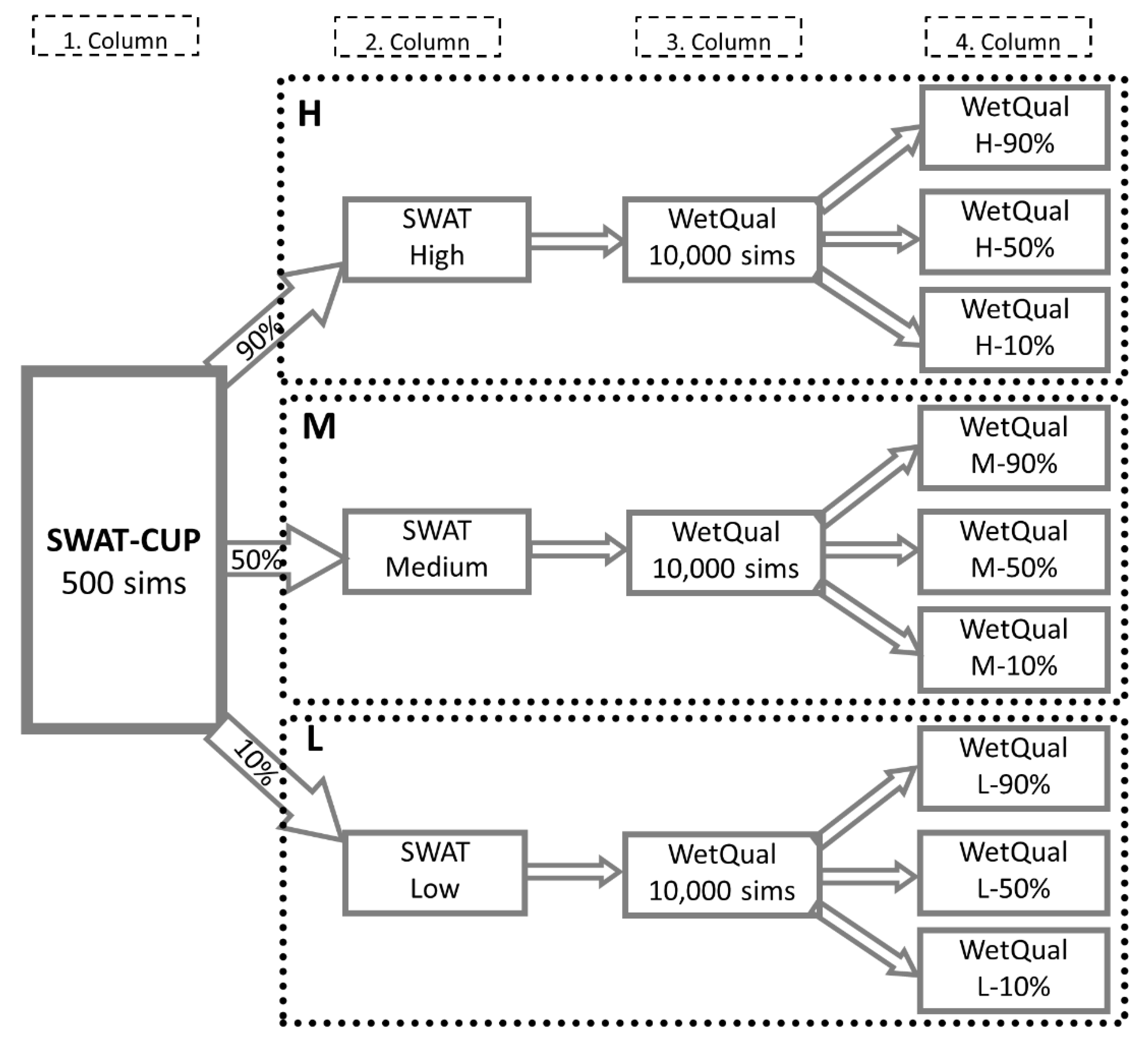
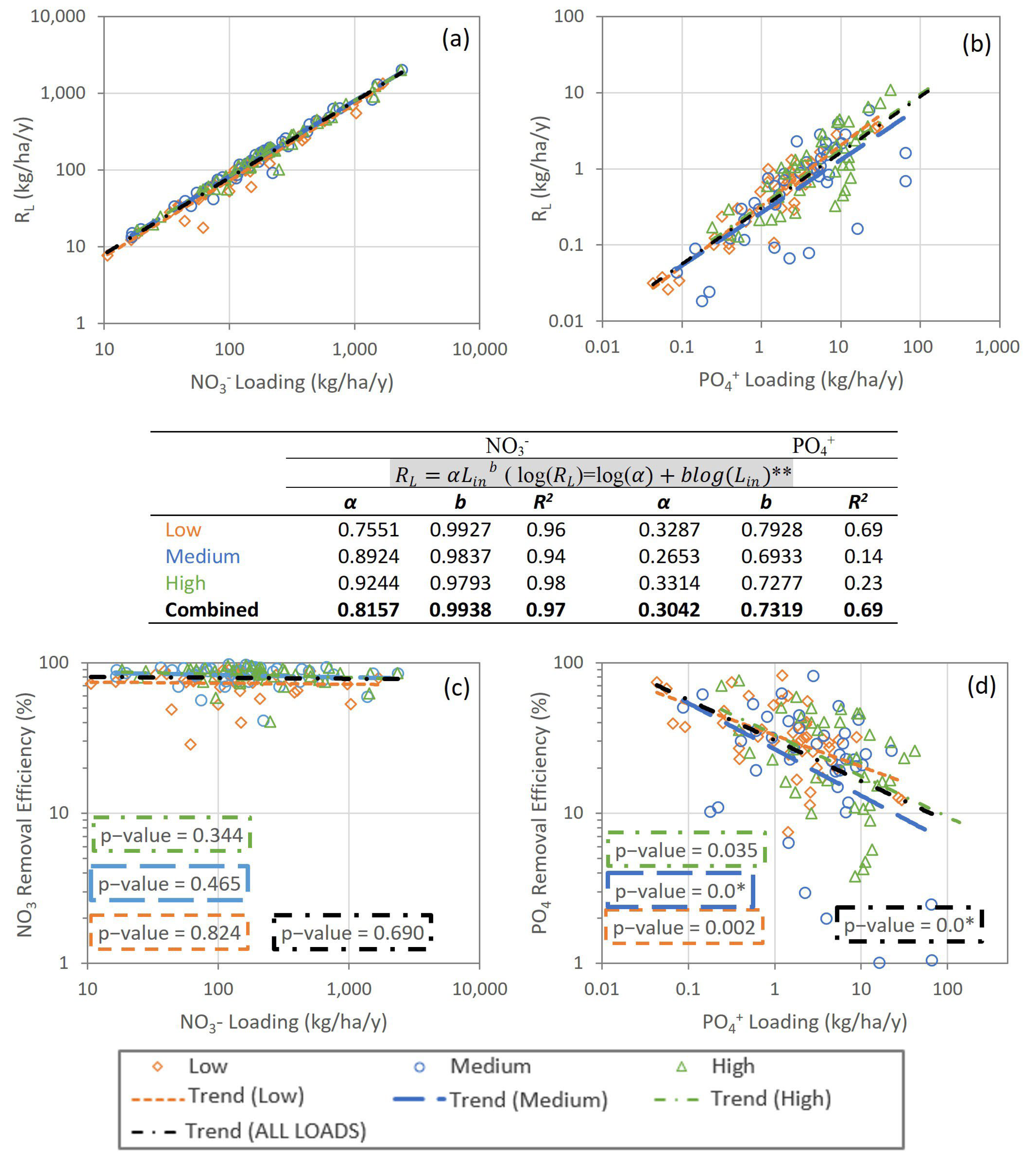
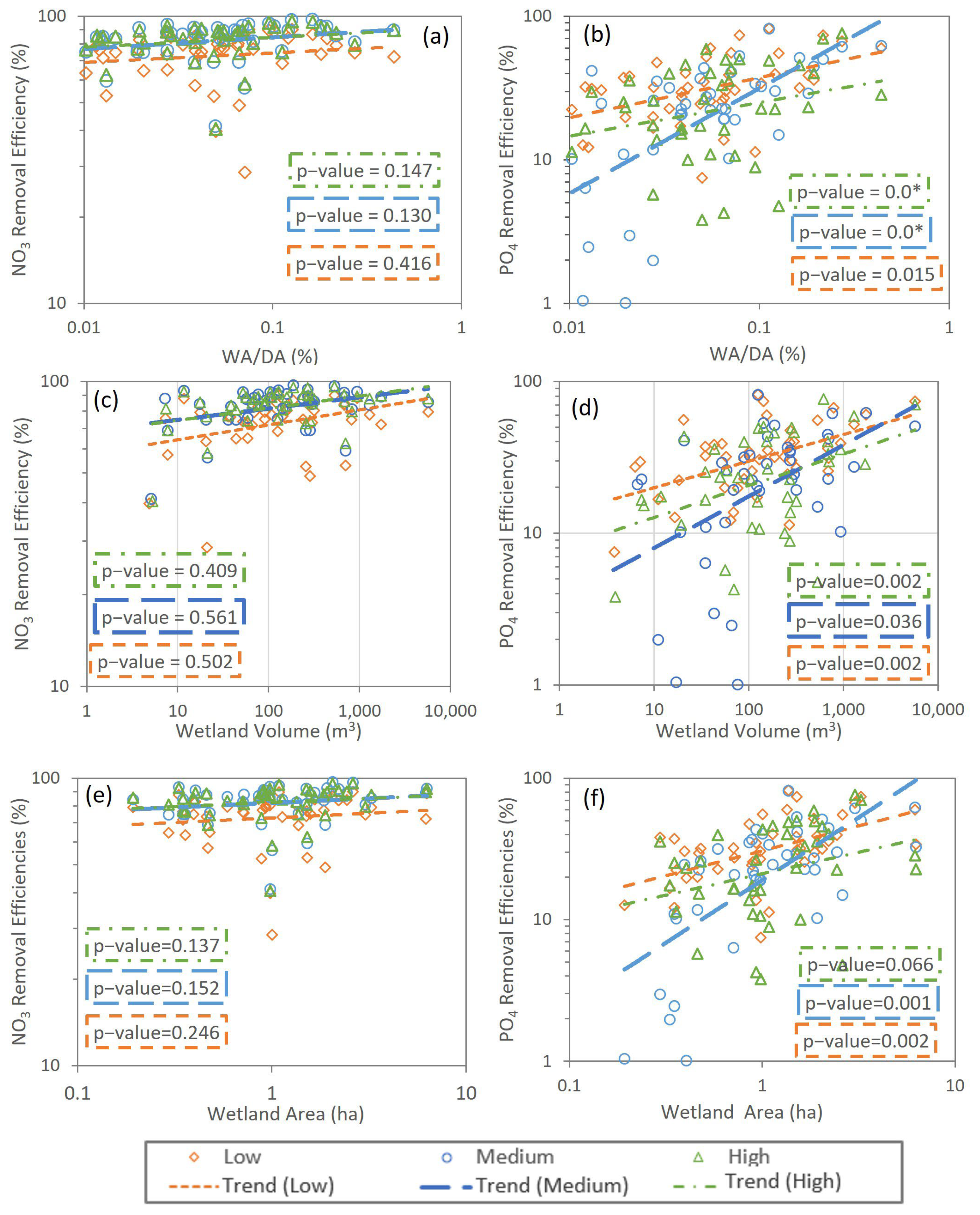
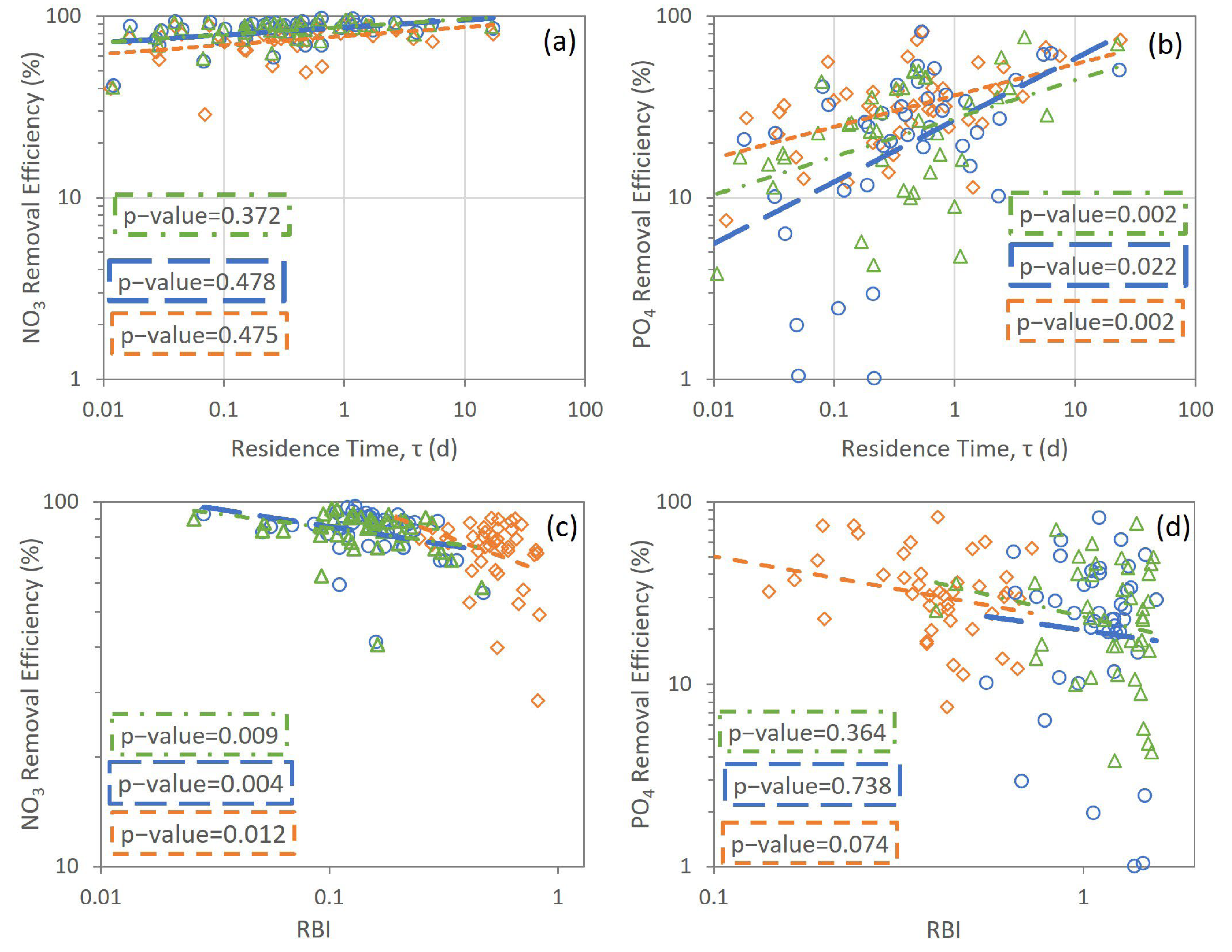
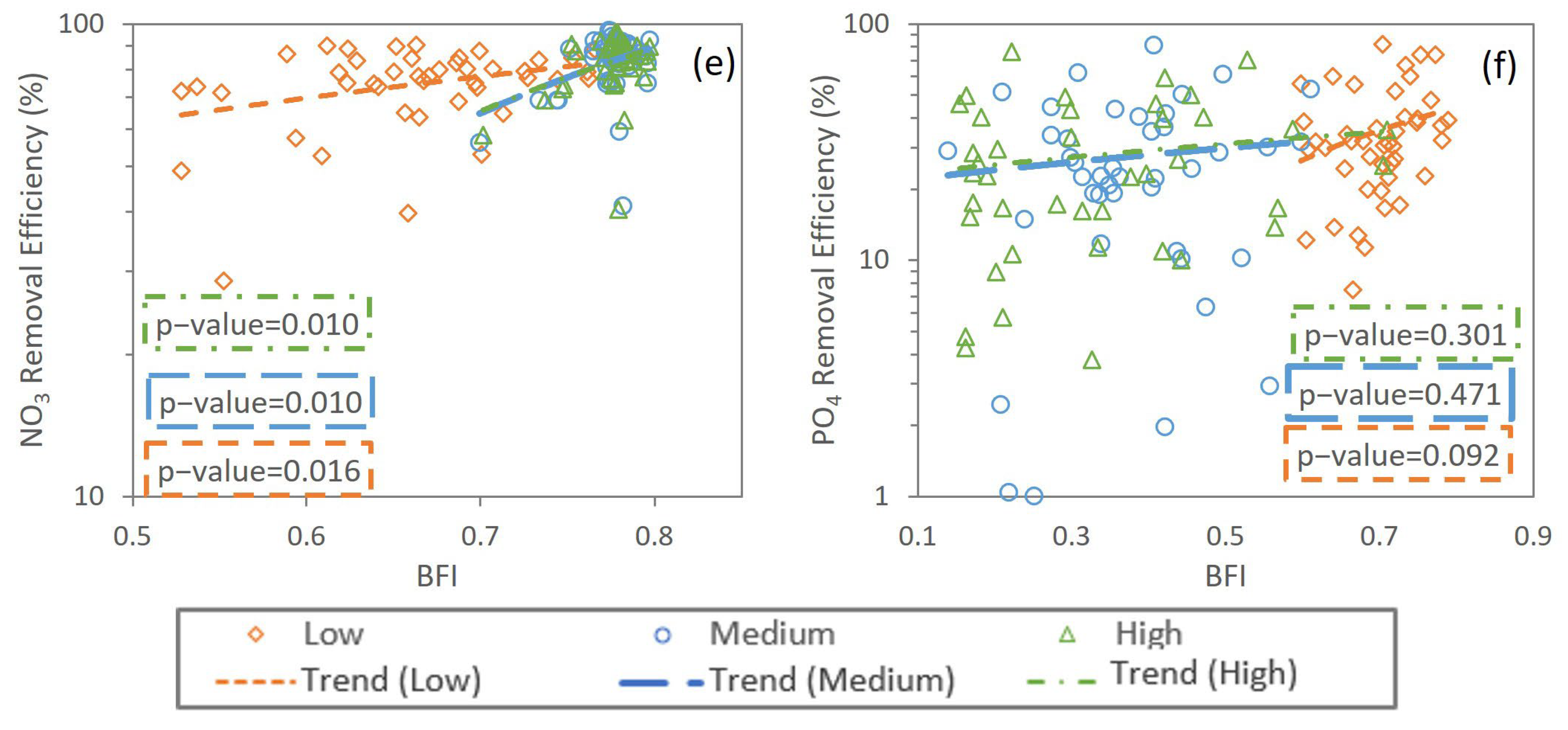

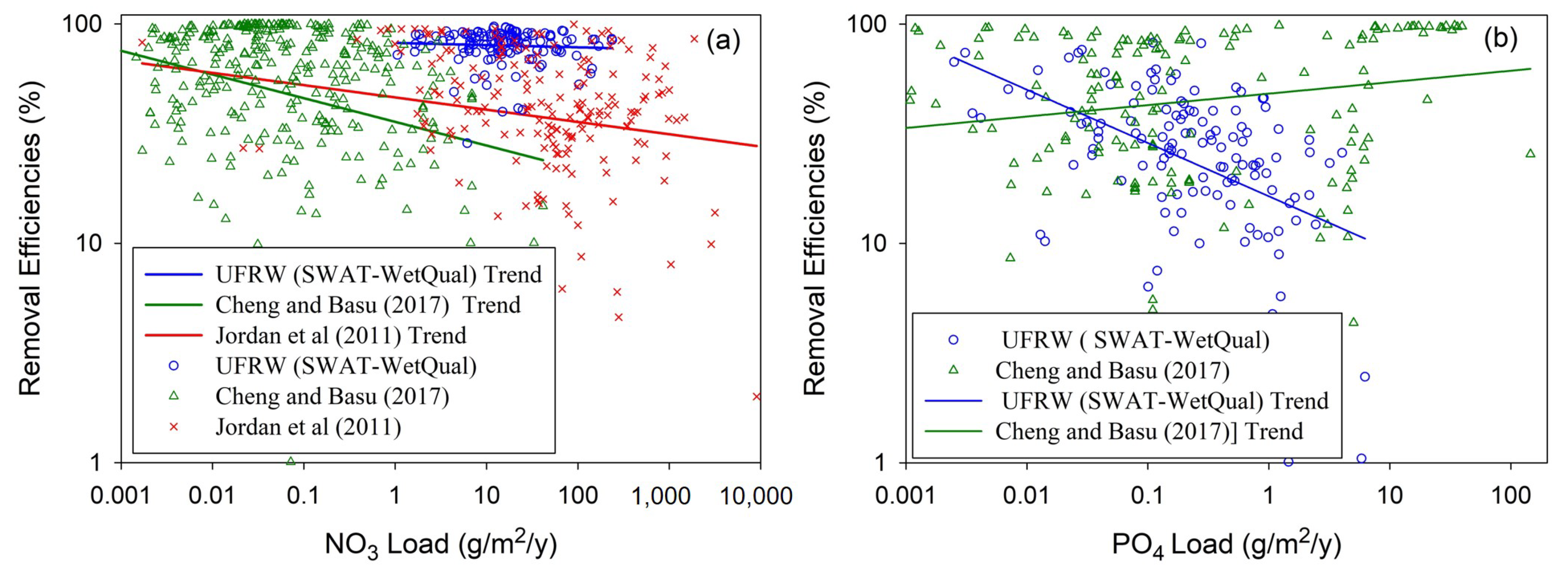
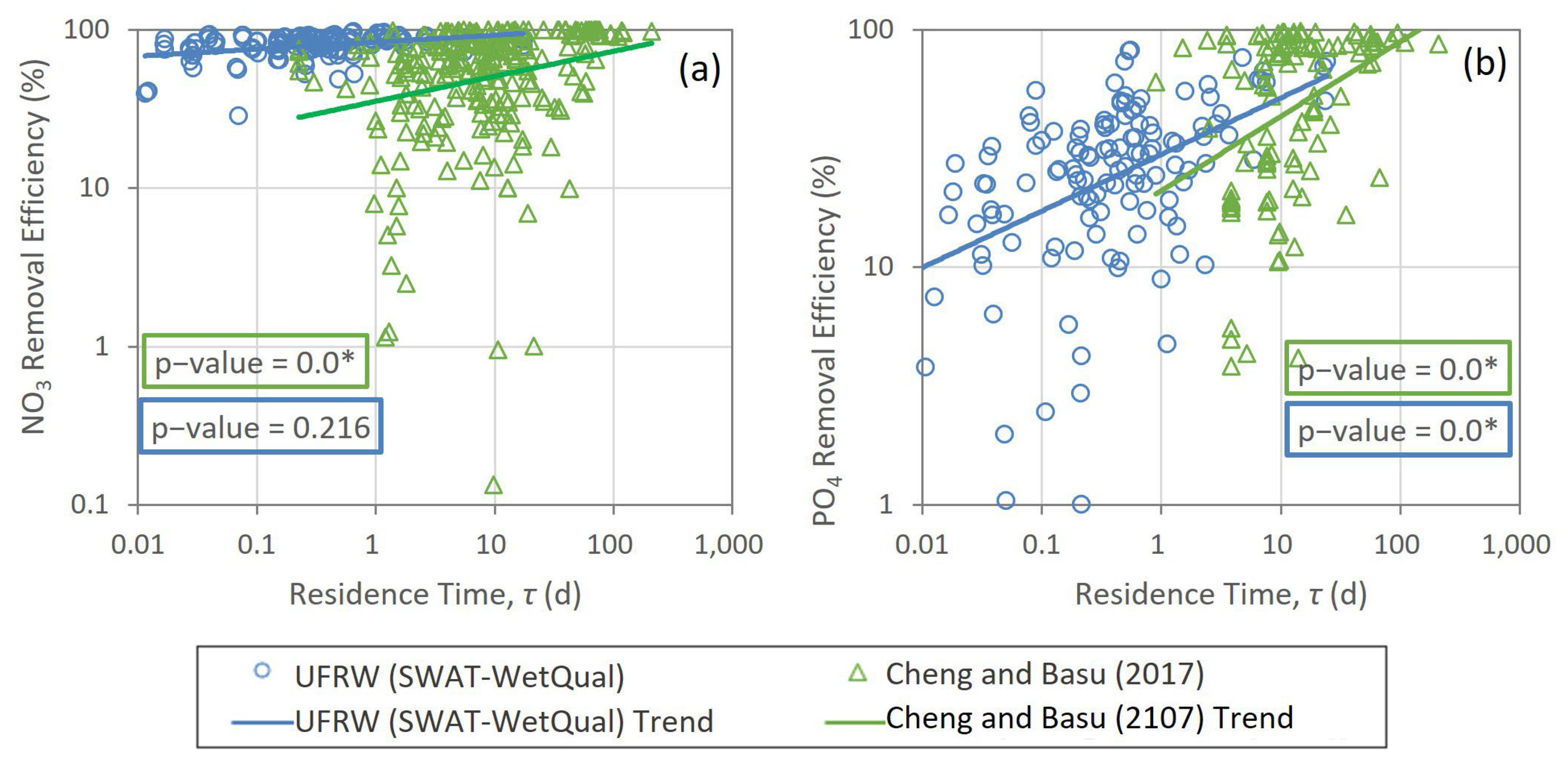
| (kg/yr) | (kg/yr) | |||||
|---|---|---|---|---|---|---|
| Low | Medium | High | Low | Medium | High | |
| Load in | 45,523 | 61,586 | 68,973 | 645 | 1457 | 2650 |
| Removal | 23,403 | 37,375 | 41,903 | 62 | 67 | 134 |
| ER(%) | 51% | 61% | 61% | 10% | 5% | 5% |
Disclaimer/Publisher’s Note: The statements, opinions and data contained in all publications are solely those of the individual author(s) and contributor(s) and not of MDPI and/or the editor(s). MDPI and/or the editor(s) disclaim responsibility for any injury to people or property resulting from any ideas, methods, instructions or products referred to in the content. |
© 2023 by the authors. Licensee MDPI, Basel, Switzerland. This article is an open access article distributed under the terms and conditions of the Creative Commons Attribution (CC BY) license (https://creativecommons.org/licenses/by/4.0/).
Share and Cite
Isik, S.; Haas, H.; Kalin, L.; Hantush, M.M.; Nietch, C. Nutrient Removal Potential of Headwater Wetlands in Coastal Plains of Alabama, USA. Water 2023, 15, 2687. https://doi.org/10.3390/w15152687
Isik S, Haas H, Kalin L, Hantush MM, Nietch C. Nutrient Removal Potential of Headwater Wetlands in Coastal Plains of Alabama, USA. Water. 2023; 15(15):2687. https://doi.org/10.3390/w15152687
Chicago/Turabian StyleIsik, Sabahattin, Henrique Haas, Latif Kalin, Mohamed M. Hantush, and Christopher Nietch. 2023. "Nutrient Removal Potential of Headwater Wetlands in Coastal Plains of Alabama, USA" Water 15, no. 15: 2687. https://doi.org/10.3390/w15152687
APA StyleIsik, S., Haas, H., Kalin, L., Hantush, M. M., & Nietch, C. (2023). Nutrient Removal Potential of Headwater Wetlands in Coastal Plains of Alabama, USA. Water, 15(15), 2687. https://doi.org/10.3390/w15152687









